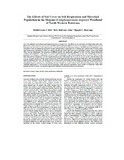| dc.contributor.author | Siele, M.P. | |
| dc.contributor.author | Mubyana-John, T. | |
| dc.contributor.author | Bonyongo, M.C. | |
| dc.date.accessioned | 2009-02-17T13:16:00Z | |
| dc.date.available | 2009-02-17T13:16:00Z | |
| dc.date.issued | 2008 | |
| dc.identifier.citation | Siele, M.P. et al (2008) The Effects of Soil Cover on Soil Respiration and Microbial Population in the Mopane (Colophospermum mopane) Woodland of North Western Botswana, Dynamic Soil, Dynamic Plant, vol. 2, no. 2, 61-68 | en |
| dc.identifier.issn | 1749-6519 | |
| dc.identifier.uri | http://hdl.handle.net/10311/292 | |
| dc.description.abstract | Soil cover influences soil biological and chemical processes in various ways. The effects of soil cover (bare soil without litter, litter cover,
Mopane tree canopy and grass cover) on soil respiration and microbial population at four sites in the Mopane woodland of north western
Botswana were investigated. Soil respiration rates were measured using an infrared gas analyzer. Nitrifying bacterial populations were
quantified by MPN on ammonium and nitrite calcium carbonate media, oligotrophs on 1% nutrient agar, actinomycetes on starch casein
agar, bacteriovorous protozoans by MPN on sodium chloride agar baited with Enterobacter, and fungal biomass carbon using buried
slides were also determined. Soil respiration in different habitats was significantly influenced by type of cover, diurnal temperature
variations and soil moisture. Soils under cover showed significantly higher soil respiration than the bare soils. Autochthonous bacterial
populations in the Mopane woodland soils consisted mostly of oligotrophs which varied insignificantly between seasons. Fungi were the
most dominant microorganisms in all the Mopane woodland soils, with biomass of 162.05 to 282.14 μg C/g soil in the wet season and
11.84 to 44.16 μg C/g soil in the dry season. Microscopic observation of buried slides revealed that fungi play a vital role in holding soil
particles together in these soils. The results showed a strong positive relationship between changes in fungal biomass and fluctuation of
soil respiration. However, no clear correlation was observed between the variation of soil respiration and other microbial populations
(oligotrophic bacteria, actinomycetes, and nitrifying bacteria). Overall these results indicate that in soils under Mopane tree canopy, fungi
contribute significantly to soil structure and soil respiration. Other microbial populations consist mostly of oligotrophs which show
minimal seasonal variations. Soil moisture significantly influences seasonal fluctuation in soil respiration. | en |
| dc.language.iso | en | en |
| dc.publisher | Global Science Books http://www.globalsciencebooks.com/index.php?page=shop.product_details&category_id=1&flypage=shop.flypage&product_id=5&option=com_virtuemart&Itemid=56&vmcchk=1&Itemid=56 | en |
| dc.subject | biomass | en |
| dc.subject | fungi | en |
| dc.subject | habitats | en |
| dc.subject | Maun | en |
| dc.subject | nitrification | en |
| dc.subject | oligotrophs | en |
| dc.title | The Effects of Soil Cover on Soil Respiration and Microbial Population in the Mopane (Colophospermum mopane) Woodland of North Western Botswana | en |
| dc.type | Published Article | en |

